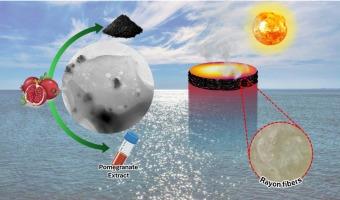A flexible photothermal device based on silver nanoparticle-integrated cellulose matrix for interfacial solar steam generation: Rethink waste and reinvigorate water
IF 9.8
1区 工程技术
Q1 ENGINEERING, CHEMICAL
引用次数: 0
Abstract
One of the most promising strategies for addressing the recent challenges in freshwater resources and energy consumption is interfacial solar steam generation (ISSG). An innovative photoreceiver constructed from a biochar (BC) matrix with Ag NPs for effective steam generation was studied to assess desalination efficiency under irradiation of one sun (1 kW m). The synthesized nanocomposites were embedded in rayon fibers, which were prepared using a simple and inexpensive cuprammonium process. The plasmonic effect of Ag NPs allows the Ag@BC-Rayon system to exhibit strong light absorption across a wide wavelength range of 280 to 2500 nm. The nanocomposite demonstrated exceptional efficiency, reaching 85.1 %, and an outstanding vaporization flux of 1.39 kg m−2 h−1 throughout one sun irradiation. Additionally, the fabricated photothermal device achieved a higher surface temperature of 44.0 °C after only 5 min of irradiation. The constructed ISSG device displayed good stability and durability after 10 cycles using saline water. The photothermal components require few and inexpensive materials, which will also bring significant economic benefits.

一种基于银纳米颗粒-集成纤维素基质的柔性光热装置,用于界面太阳能蒸汽产生:重新思考浪费和重新激活水
界面太阳能蒸汽发电(ISSG)是解决淡水资源和能源消耗最近挑战的最有前途的战略之一。研究了一种由生物炭(BC)基质和Ag NPs构建的创新光接收器,用于有效产生蒸汽,以评估一个太阳(1 kW m)照射下的海水淡化效率。将合成的纳米复合材料包埋在人造丝纤维中,采用简单、廉价的铜铵工艺制备。银纳米粒子的等离子体效应使Ag@BC-Rayon系统在280至2500 nm的宽波长范围内表现出强烈的光吸收。该纳米复合材料表现出优异的效率,达到85.1%,在一次太阳照射下的蒸发通量为1.39 kg m−2 h−1。此外,制备的光热器件在辐照5min后表面温度达到了44.0℃。经10次盐水循环后,所制成的ISSG装置表现出良好的稳定性和耐久性。光热组件所需材料少且价格低廉,也将带来显著的经济效益。
本文章由计算机程序翻译,如有差异,请以英文原文为准。
求助全文
约1分钟内获得全文
求助全文
来源期刊

Desalination
工程技术-工程:化工
CiteScore
14.60
自引率
20.20%
发文量
619
审稿时长
41 days
期刊介绍:
Desalination is a scholarly journal that focuses on the field of desalination materials, processes, and associated technologies. It encompasses a wide range of disciplines and aims to publish exceptional papers in this area.
The journal invites submissions that explicitly revolve around water desalting and its applications to various sources such as seawater, groundwater, and wastewater. It particularly encourages research on diverse desalination methods including thermal, membrane, sorption, and hybrid processes.
By providing a platform for innovative studies, Desalination aims to advance the understanding and development of desalination technologies, promoting sustainable solutions for water scarcity challenges.
 求助内容:
求助内容: 应助结果提醒方式:
应助结果提醒方式:


